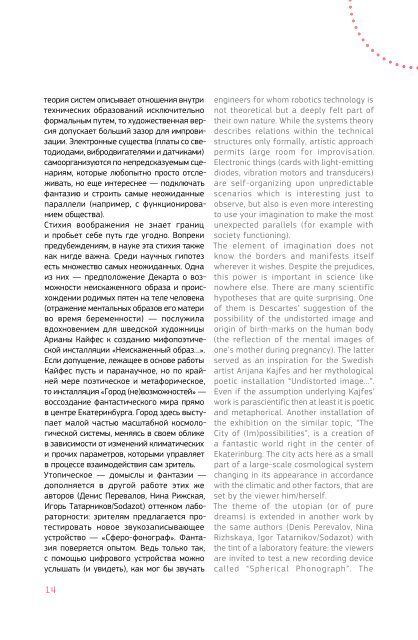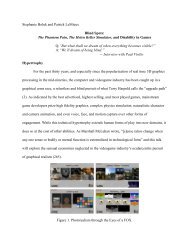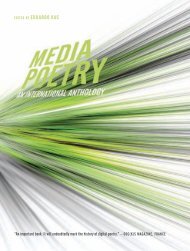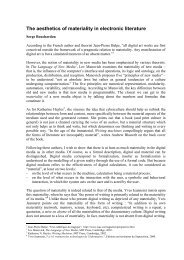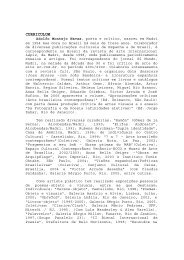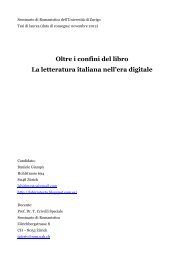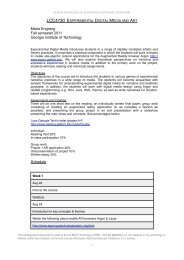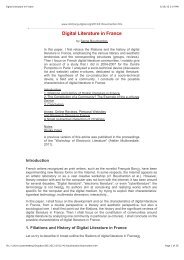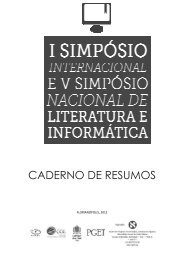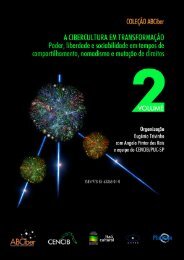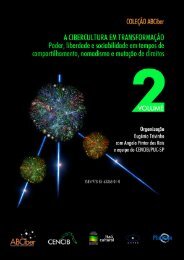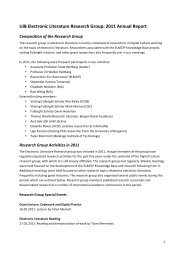ÑÐµÑ Ð½Ð¾Ð»Ð¾Ð³Ð¸Ð¸ в ÑокÑÑе иÑкÑÑÑÑва: оÑаÑование и вÑзов - ELMCIP
ÑÐµÑ Ð½Ð¾Ð»Ð¾Ð³Ð¸Ð¸ в ÑокÑÑе иÑкÑÑÑÑва: оÑаÑование и вÑзов - ELMCIP
ÑÐµÑ Ð½Ð¾Ð»Ð¾Ð³Ð¸Ð¸ в ÑокÑÑе иÑкÑÑÑÑва: оÑаÑование и вÑзов - ELMCIP
- No tags were found...
Create successful ePaper yourself
Turn your PDF publications into a flip-book with our unique Google optimized e-Paper software.
теория систем описывает отношения внутритехнических образований исключительноформальным путем, то художественная версиядопускает больший зазор для импровизации.Электронные существа (платы со светодиодами,вибродвигателями и датчиками)самоорганизуются по непредсказуемым сценариям,которые любопытно просто отслеживать,но еще интереснее — подключатьфантазию и строить самые неожиданныепараллели (например, с функционированиемобщества).Стихия воображения не знает граници пробьет себе путь где угодно. Вопрекипредубеждениям, в науке эта стихия такжекак нигде важна. Среди научных гипотезесть множество самых неожиданных. Однаиз них — предположение Декарта о возможностинеискаженного образа и происхожденииродимых пятен на теле человека(отражение ментальных образов его материво время беременности) — послужилавдохновением для шведской художницыАрианы Кайфес к созданию мифопоэтическойинсталляции «Неискаженный образ…».Если допущение, лежащее в основе работыКайфес пусть и паранаучное, но по крайнеймере поэтическое и метафорическое,то инсталляция «Город (не)возможностей» —воссоздание фантастического мира прямов центре Екатеринбурга. Город здесь выступаетмалой частью масштабной космологическойсистемы, меняясь в своем обликев зависимости от изменений климатическихи прочих параметров, которыми управляетв процессе взаимодействия сам зритель.Утопическое — домыслы и фантазии —дополняется в другой работе этих жеавторов (Денис Перевалов, Нина Рижская,Игорь Татарников/Sodazot) оттенком лабораторности:зрителям предлагается протестироватьновое звукозаписывающееустройство — «Сферо-фонограф». Фантазияповеряется опытом. Ведь только так,с помощью цифрового устройства можноуслышать (и увидеть), как мог бы звучатьengineers for whom robotics technology isnot theoretical but a deeply felt part oftheir own nature. While the systems theorydescribes relations within the technicalstructures only formally, artistic approachpermits large room for improvisation.Electronic things (cards with light-emittingdiodes, vibration motors and transducers)are self-organizing upon unpredictablescenarios which is interesting just toobserve, but also is even more interestingto use your imagination to make the mostunexpected parallels (for example withsociety functioning).The element of imagination does notknow the borders and manifests itselfwherever it wishes. Despite the prejudices,this power is important in science likenowhere else. There are many scientifichypotheses that are quite surprising. Oneof them is Descartes’ suggestion of thepossibility of the undistorted image andorigin of birth-marks on the human body(the reflection of the mental images ofone’s mother during pregnancy). The latterserved as an inspiration for the Swedishartist Arijana Kajfes and her mythologicalpoetic installation “Undistorted image…”.Even if the assumption underlying Kajfes’work is parascientific then at least it is poeticand metaphorical. Another installation ofthe exhibition on the similar topic, “TheCity of (Im)possibilities”, is a creation ofa fantastic world right in the center ofEkaterinburg. The city acts here as a smallpart of a large-scale cosmological systemchanging in its appearance in accordancewith the climatic and other factors, that areset by the viewer him/herself.The theme of the utopian (or of puredreams) is extended in another work bythe same authors (Denis Perevalov, NinaRizhskaya, Igor Tatarnikov/Sodazot) withthe tint of a laboratory feature: the viewersare invited to test a new recording devicecalled “Spherical Phonograph”. Theзвук, если его воспроизводить, изменяянаклон самого звуковоспроизводящегоустройства — в данном случае iPad’a.Совсем иная версия «поверки опытом»в созданной специально к выставке(наряду с работами других екатеринбургскихавторов) интерактивной видеоинсталляции«Осадок» известной группы«Куда бегут собаки». Реальности здесьизначально нет доверия, от нее можноожидать чего угодно. Эффект неожиданностиподготавливает уже центральныйобраз — настораживающий и пугающийсвоей гипертрофированной натуральностьюкартофель.Лабораторные эксперименты с возможностямицифровых технологий или жеопыты телесного вовлечения в процесссоздания работы — все это не можетсуществовать в отрыве от самой жизнии, в особенности, от контекста экономикии массовой культуры. Художники объединенияElectroboutique (Аристарх Чернышеви Алексей Шульгин) задались цельювмешаться в логику отношений междуискусством и индустрией развлечений. Ихуникальные электронные объекты (парафразына тему популярных устройств, такихкак iPod или диодные бегущие строки)основаны на парадоксе, и провокации.В них обнажаются структуры производствамассового электронного продукта,что и привносит в эти произведения критическийзаряд.Electroboutique как нельзя лучше собираетвоедино интонации очарования и вызовапо отношению к технологичному искусству.Тем не менее, выбор и интерпретациявсегда за зрителем-потребителем.Фокус искусства — это зазор, перспектива,позволяющая увидеть более широкую картину,эмоция (ироничная/критичная), котораявсегда индивидуальна, всегда возвращаетнас к самим себе и напоминает,где же искать ответы на вопросы.fantasy is tested with the experience. Onlythis way with the help of the digital devicea man can hear (and see) what the soundmight be if reproduced when changing theslope of the reproducing device itself — inthe present case that of iPad.Quite another version of “the test withexperience” is characteristic to the interactive video installation “The Aftertaste”by a famous Ural group “Where the DogsRun” (the installation was specially createdfor the exhibition along with the worksby other Ekaterinburg based artists). Thereality is initially mistrusted here, and theeffect of suddenness is already prepared bythe central image — alerting, intimidatingand hypernaturally looking falling potatoes.Laboratory like projects that explore thepossibilities of digital technologies, or theexperiences of body engagement to thecreation of an artwork — all of this cannotexist in isolation from life, especiallyfrom the context of economics and massculture. The artists of “Electroboutique”(Aristarkh Chernyshev, Alexei Shulgin) aimto interfere into the logics of the relationshipbetween art and entertainment industry.Their unique electronic objects (a paraphraseon the topic of popular devices, such as iPodor LED creeping lines) are based on paradoxand provocation. They disclose the structuresof mass electronic product manufacture,and this is exactly what adds to the criticalcharge of the works.Electroboutique assembles togetherintonations of excitement and challenge inrelation to the technological art in thebest possible way. Nevertheless, the finalchoice and interpretation always stays withthe viewer and consumer.An “art focus” is a clearance/gap and aperspective that permits to see a widerpicture, an emotion (ironical/critical) that isalways individual and always turns us backto ourselves and reminds us where to searchfor the answers to our questions.14 15


